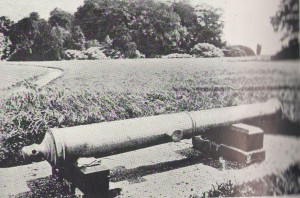Cellini’s Canon April 20, 2011
Author: Beach Combing | in : Modern , trackback Beachcombing has been thinking in the last hour about objects that are far travelled – for example the Indian buddhas that made it to Viking Scandinavia or, say, the Viking coin that (allegedly) ended up in pre-Columbian Maine. And it was while musing on these far-flung things that Cellini’s canon came to mind.
Beachcombing has been thinking in the last hour about objects that are far travelled – for example the Indian buddhas that made it to Viking Scandinavia or, say, the Viking coin that (allegedly) ended up in pre-Columbian Maine. And it was while musing on these far-flung things that Cellini’s canon came to mind.
Now admittedly this object travelled in a shorter compass but it was, between its creation in the mid sixteenth century and its final firing in 1854, used by three different nations in their wars . As such perhaps it too deserves celebration…
The bronze canon was made by the renaissance genius Benvenuto Cellini between 1537 and 1545 when he was causing trouble at the court of the French king Francis I (obit 1547). It, in fact, has Cellini’s device emblazoned upon it.
The next phase of the canon’s biography is the most obscure because it somehow changed country ending in the hands of the Spanish crown: it has been suggested that it was captured in one of France’s Italian wars. Certainly it very likely went over to the enemy through conflict rather than as a gift or purchase.
Here, in any case, Cellini’s canon entered the most exciting, if disastrous phase of its life. It was, in 1588, loaded on to a Spanish galleon – variously called the Florida or the San Juan de Sicilia: the boat’s identity is uncertain – and sent off to join the Armada on its planned invasion of Elizabeth’s England.
The canon’s ship – by whichever name it went – was not as unlucky as some of its comrades. It was not caught by English fire-ships or even wrecked by winds on the unforgiving British shore. Rather it was one of the survivors that tried, unwisely perhaps, to escape back to Spain by passing north around Scotland and then down through the Irish Sea to Biscay.
Here, however, catastrophe struck. The Spanish vessel dropped anchor off Mull, in Tobermory Bay to bring on provisions and prepare for the homeward voyage. The crew had enough powder to keep the locals off so there was no danger there. The problem was that their captain foolishly got embroiled in a local clan war (another post, another day) that ended with his ship being blown up in the water: likely by a Scottish prisoner who carried out a suicide attack.
Cellini’s canon disappeared with the vessel into the dark waters of Tobermory Bay. The memory of the wreck – said by some to be carry the treasure of the Armada – meant though that already in 1661 diving expeditions were sent down to retrieve gold.
Beachcombing might note paranthetically that some of these seventeenth-century trips used diving bells: perhaps like those described in a mermaid tale set in these times and associated with the Isle of Man; a story which was recently published here.
Slowly objects were picked up out of the smashed pieces of timber and Cellini’s gun was finally pulled, glugging, from the depths in 1740 – after almost two hundred years in the salt.
It found a new home at Inveraray Castle, the home of the Duke of Argyll, who holds rights over the sunken Spanish vessel. And here Cellini’s masterpiece had its final moment of martial glory when it was fired in the reign of Queen Victoria in 1854 to celebrate Alma, the first Allied victory of the Crimean War.
There was some justice in this as, of course, the French – the original owners of the gun, the Piedmontese – the closest there was to Cellini’s Italy at this date – and the Scots (as part of the British army) were all fighting on the Allied side.
Beachcombing is always on the look out for objects with unusual histories particularly if they involve treasure troves: drbeachcombing AT yahoo DOT com


